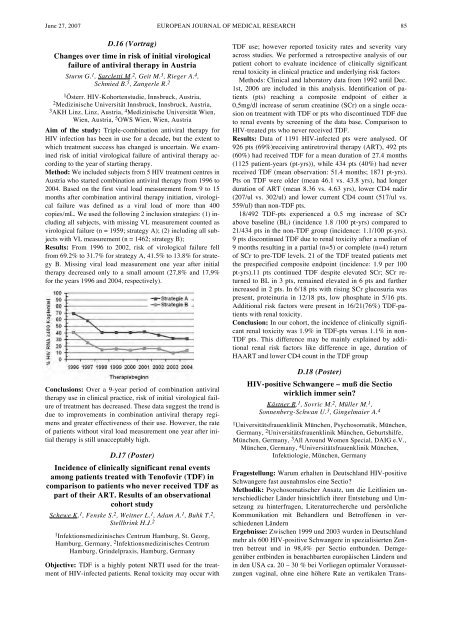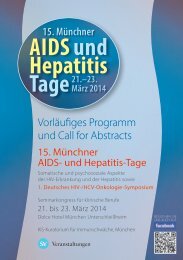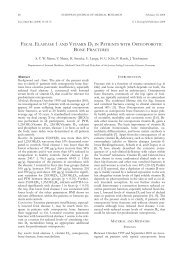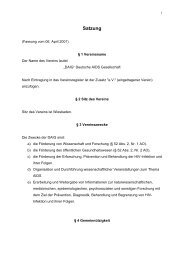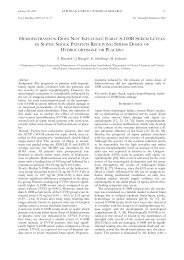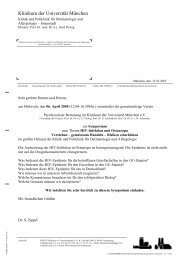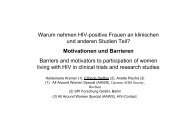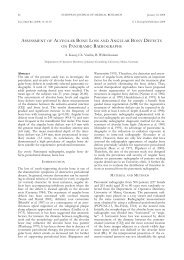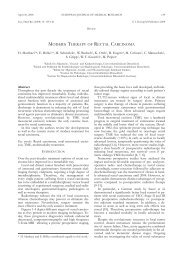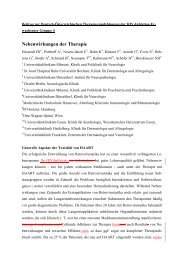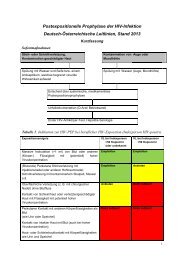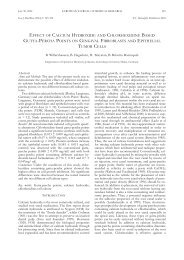European Journal of Medical Research - Deutsche AIDS ...
European Journal of Medical Research - Deutsche AIDS ...
European Journal of Medical Research - Deutsche AIDS ...
You also want an ePaper? Increase the reach of your titles
YUMPU automatically turns print PDFs into web optimized ePapers that Google loves.
June 27, 2007 EUROPEAN JOURNAL OF MEDICAL RESEARCH<br />
85<br />
D.16 (Vortrag)<br />
Changes over time in risk <strong>of</strong> initial virological<br />
failure <strong>of</strong> antiviral therapy in Austria<br />
Sturm G. 1 , Sarcletti M. 2 , Geit M. 3 , Rieger A. 4 ,<br />
Schmied B. 5 , Zangerle R. 2<br />
1 Österr. HIV-Kohortenstudie, Innsbruck, Austria,<br />
2 Medizinische Universität Innsbruck, Innsbruck, Austria,<br />
3 AKH Linz, Linz, Austria, 4 Medizinische Universität Wien,<br />
Wien, Austria, 5 OWS Wien, Wien, Austria<br />
Aim <strong>of</strong> the study: Triple-combination antiviral therapy for<br />
HIV infection has been in use for a decade, but the extent to<br />
which treatment success has changed is uncertain. We examined<br />
risk <strong>of</strong> initial virological failure <strong>of</strong> antiviral therapy according<br />
to the year <strong>of</strong> starting therapy.<br />
Method: We included subjects from 5 HIV treatment centres in<br />
Austria who started combination antiviral therapy from 1996 to<br />
2004. Based on the first viral load measurement from 9 to 15<br />
months after combination antiviral therapy initiation, virological<br />
failure was defined as a viral load <strong>of</strong> more than 400<br />
copies/mL. We used the following 2 inclusion strategies: (1) including<br />
all subjects, with missing VL measurement counted as<br />
virological failure (n = 1959; strategy A); (2) including all subjects<br />
with VL measurement (n = 1462; strategy B);<br />
Results: From 1996 to 2002, risk <strong>of</strong> virological failure fell<br />
from 69.2% to 31.7% for strategy A, 41.5% to 13.8% for strategy<br />
B. Missing viral load measurement one year after initial<br />
therapy decreased only to a small amount (27,8% and 17,9%<br />
for the years 1996 and 2004, respectively).<br />
Conclusions: Over a 9-year period <strong>of</strong> combination antiviral<br />
therapy use in clinical practice, risk <strong>of</strong> initial virological failure<br />
<strong>of</strong> treatment has decreased. These data suggest the trend is<br />
due to improvements in combination antiviral therapy regimens<br />
and greater effectiveness <strong>of</strong> their use. However, the rate<br />
<strong>of</strong> patients without viral load measurement one year after initial<br />
therapy is still unacceptably high.<br />
D.17 (Poster)<br />
Incidence <strong>of</strong> clinically significant renal events<br />
among patients treated with Ten<strong>of</strong>ovir (TDF) in<br />
comparison to patients who never received TDF as<br />
part <strong>of</strong> their ART. Results <strong>of</strong> an observational<br />
cohort study<br />
Schewe K. 1 , Fenske S. 2 , Weitner L. 1 , Adam A. 1 , Buhk T. 2 ,<br />
Stellbrink H.J. 2<br />
1 Infektionsmedizinisches Centrum Hamburg, St. Georg,<br />
Hamburg, Germany, 2 Infektionsmedizinisches Centrum<br />
Hamburg, Grindelpraxis, Hamburg, Germany<br />
Objective: TDF is a highly potent NRTI used for the treatment<br />
<strong>of</strong> HIV-infected patients. Renal toxicity may occur with<br />
TDF use; however reported toxicity rates and severity vary<br />
across studies. We performed a retrospective analysis <strong>of</strong> our<br />
patient cohort to evaluate incidence <strong>of</strong> clinically significant<br />
renal toxicity in clinical practice and underlying risk factors<br />
Methods: Clinical and laboratory data from 1992 until Dec.<br />
1st, 2006 are included in this analysis. Identification <strong>of</strong> patients<br />
(pts) reaching a composite endpoint <strong>of</strong> either �<br />
0,5mg/dl increase <strong>of</strong> serum creatinine (SCr) on a single occasion<br />
on treatment with TDF or pts who discontinued TDF due<br />
to renal events by screening <strong>of</strong> the data base. Comparison to<br />
HIV-treated pts who never received TDF.<br />
Results: Data <strong>of</strong> 1191 HIV-infected pts were analysed. Of<br />
926 pts (69%)receiving antiretroviral therapy (ART), 492 pts<br />
(60%) had received TDF for a mean duration <strong>of</strong> 27.4 months<br />
(1125 patient-years (pt-yrs)), while 434 pts (40%) had never<br />
received TDF (mean observation: 51.4 months; 1871 pt-yrs).<br />
Pts on TDF were older (mean 46.1 vs. 43.8 yrs), had longer<br />
duration <strong>of</strong> ART (mean 8.36 vs. 4.63 yrs), lower CD4 nadir<br />
(207/ul vs. 302/ul) and lower current CD4 count (517/ul vs.<br />
559/ul) than non-TDF pts.<br />
18/492 TDF-pts experienced a 0.5 mg increase <strong>of</strong> SCr<br />
above baseline (BL) (incidence 1.8 /100 pt-yrs) compared to<br />
21/434 pts in the non-TDF group (incidence: 1.1/100 pt-yrs).<br />
9 pts discontinued TDF due to renal toxicity after a median <strong>of</strong><br />
9 months resulting in a partial (n=5) or complete (n=4) return<br />
<strong>of</strong> SCr to pre-TDF levels. 21 <strong>of</strong> the TDF treated patients met<br />
the prespecified composite endpoint (incidence: 1.9 per 100<br />
pt-yrs).11 pts continued TDF despite elevated SCr; SCr returned<br />
to BL in 3 pts, remained elevated in 6 pts and further<br />
increased in 2 pts. In 6/18 pts with rising SCr glucosuria was<br />
present, proteinuria in 12/18 pts, low phosphate in 5/16 pts.<br />
Additional risk factors were present in 16/21(76%) TDF-patients<br />
with renal toxicity.<br />
Conclusion: In our cohort, the incidence <strong>of</strong> clinically significant<br />
renal toxicity was 1.9% in TDF-pts versus 1.1% in non-<br />
TDF pts. This difference may be mainly explained by additional<br />
renal risk factors like difference in age, duration <strong>of</strong><br />
HAART and lower CD4 count in the TDF group<br />
D.18 (Poster)<br />
HIV-positive Schwangere – muß die Sectio<br />
wirklich immer sein?<br />
Kästner R. 1 , Sovric M. 2 , Müller M. 1 ,<br />
Sonnenberg-Schwan U. 3 , Gingelmaier A. 4<br />
1 Universitätsfrauenklinik München, Psychosomatik, München,<br />
Germany, 2 Universitätsfrauenklinik München, Geburtshilfe,<br />
München, Germany, 3 All Around Women Special, DAIG e.V.,<br />
München, Germany, 4 Universitätsfrauenklinik München,<br />
Infektiologie, München, Germany<br />
Fragestellung: Warum erhalten in Deutschland HIV-positive<br />
Schwangere fast ausnahmslos eine Sectio?<br />
Methodik: Psychosomatischer Ansatz, um die Leitlinien unterschiedlicher<br />
Länder hinsichtlich ihrer Entstehung und Umsetzung<br />
zu hinterfragen, Literaturrecherche und persönliche<br />
Kommunikation mit Behandlern und Betr<strong>of</strong>fenen in verschiedenen<br />
Ländern<br />
Ergebnisse: Zwischen 1999 und 2003 wurden in Deutschland<br />
mehr als 600 HIV-positive Schwangere in spezialisierten Zentren<br />
betreut und in 98,4% per Sectio entbunden. Demgegenüber<br />
entbinden in benachbarten europäischen Ländern und<br />
in den USA ca. 20 – 30 % bei Vorliegen optimaler Voraussetzungen<br />
vaginal, ohne eine höhere Rate an vertikalen Trans-


